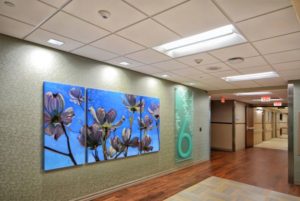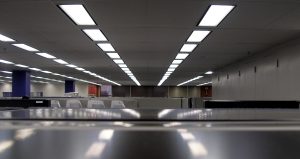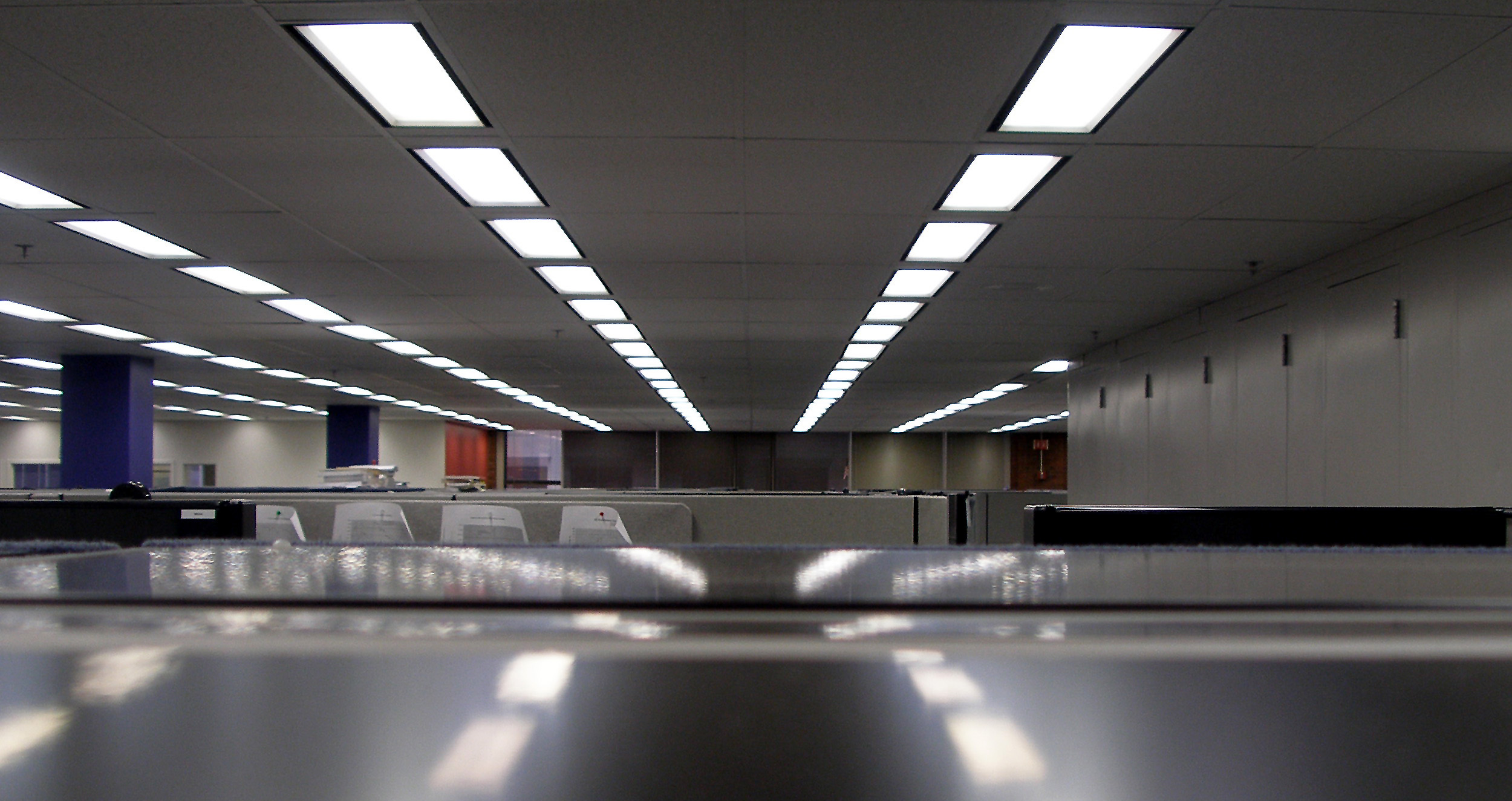Commercial lighting design is essential for creating functional, visually appealing, and energy-efficient spaces. The proper lighting setup improves productivity, enhances well-being, and strengthens brand identity. By understanding the core principles and emerging trends in lighting design, businesses can make informed decisions that benefit their operations and employees.
Key Takeaways:
1. When designing a commercial lighting system, key factors include functionality, branding, and employee well-being.
- During the design process, get input from managers and other stakeholders and prioritize elements like accessibility and cost savings.
- Consult a team of professional electricians to help you design the optimal lighting layout for your commercial building.
The Importance of Commercial Lighting Design

Lighting does far more than illuminate a space—it sets the tone for how a business operates and how it is perceived. Here’s why it matters:
Functionality and Productivity
Effective lighting ensures that employees can perform tasks efficiently and safely. Poorly lit environments can lead to eye strain, fatigue, and accidents, directly impacting productivity. Proper task lighting in workspaces minimizes these risks and helps employees stay focused.
Employee Well-being
Lighting design significantly influences mood and mental health. Incorporating natural light or lighting that mimics natural cycles can improve circadian rhythms, boost energy, and reduce stress. Lighting is particularly important in offices, warehouses, and retail spaces where employees spend extended hours indoors.
Branding and Aesthetics
Lighting is a key part of a company’s brand experience. From welcoming, warm tones in hospitality settings to sleek, modern fixtures in high-tech offices, lighting design communicates a business’s values and style and creates a memorable impression for clients and customers.
Key Steps in Designing Commercial Lighting Solutions
A successful lighting project starts with careful planning and a deep understanding of the space and its needs.
Understanding Space Requirements
Conducting a Site Survey
Each space comes with unique architectural features, dimensions, and existing infrastructure that you’ll need to consider:
- Ceiling Height and Room Dimensions: High ceilings may require suspended or high bay lighting, while low ceilings are better suited for recessed fixtures.
- Natural Light Availability: To reduce energy usage, maximize daylighting opportunities, and identify areas where artificial light should be supplemented at different times.
- Electrical Infrastructure: Determine if the current wiring can support new fixtures or if upgrades are required.
Engaging with Stakeholders
Lighting design isn’t a solo effort—it requires collaboration with key decision-makers. In commercial lighting design, communication, and stakeholder input are crucial for several reasons:
- Meeting User Needs:
- Functionality: Lighting directly impacts how people work and interact within a space. Facility managers and end-users (employees, customers) can provide invaluable insights into their needs. For example, office workers may require adjustable lighting for different tasks (desk work vs. meetings), while retail stores need lighting to showcase products effectively.
- Comfort: Lighting can significantly impact comfort and well-being. User input helps ensure the lighting doesn’t cause glare, shadows, or discomfort, leading to increased productivity and satisfaction.
- Aligning with Business Goals:
- Energy Efficiency: Facility managers are often concerned about energy costs. Their input helps prioritize energy-efficient solutions like LED lighting, daylighting, and smart controls.
- Budget and Timeline Considerations:
- Cost-Effectiveness: Stakeholder input helps identify the most cost-effective solutions that meet their needs.
- Project Timeline: Early communication helps establish realistic timelines and avoid delays caused by unforeseen requirements or changes.
- Preventing Issues and Ensuring Success:
- Reduced Risk of Dissatisfaction: By involving stakeholders early on, designers can address potential concerns and avoid costly redesigns or retrofitting later.
- Improved Communication and Collaboration:
- Fosters a collaborative environment between designers, stakeholders, and contractors.
- Builds trust and strengthens relationships.
By actively seeking and incorporating stakeholder input, lighting designers can create more effective, user-centered, and successful lighting solutions for commercial spaces.
Identifying Constraints
No project is without limitations, and addressing them early in planning can prevent costly revisions. When budgeting for a commercial lighting project, you should set realistic limits while prioritizing high-impact areas.
Compliance with local codes, safety regulations, and industry standards is essential throughout the process. Finally, aligning the project timeline with business operations helps minimize disruption and ensure a smooth implementation.
Creating a Tailored Lighting Plan
A successful commercial lighting plan seamlessly blends technical expertise with a captivating design vision. This involves carefully selecting fixtures that don’t just illuminate the space effectively; they should enhance its overall aesthetic.
Equally important is a robust emergency lighting plan that ensures safe evacuation routes through reliable backup systems and strict compliance with all relevant safety codes. Finally, long-term success hinges on proactive maintenance planning. By investing in durable, energy-efficient fixtures and implementing a proactive maintenance strategy, businesses can significantly reduce long-term costs while ensuring optimal lighting performance throughout the system’s lifespan.
Fixture Selection and Application
Now that we’ve explored key aspects of commercial lighting design, it’s time to examine specific fixtures more deeply. The right fixture will depend on the type of commercial space, and choosing the correct one ensures optimal functionality and aesthetic harmony.

Fixtures for Office Spaces
- Popular Choices: Linear LEDs, recessed troffers, desk lamps.
- Key Considerations: Minimize glare to reduce eye strain and ensure fixtures complement the interior design. Flexible controls allow for personalized lighting adjustments in individual workspaces.
Fixtures for Industrial and Warehouse Spaces
- Popular Choices: High bays, low bays, task lights.
- Key Considerations: Durability is paramount in these environments. Choose fixtures that can withstand dust, humidity, and vibration. Incorporate motion sensors for energy savings in low-traffic areas.
Fixtures for Outdoor and Parking Areas
- Popular Choices: LED area lights, bollard lights, wall packs.
- Key Considerations: Weather-resistant fixtures ensure reliability. To reduce costs, include features like integrated sensors for motion detection and daylight harvesting.
Optimizing Color Temperature and CRI
- Offices: Neutral to cool tones (3500K–5000K) foster focus and productivity.
- Warehouses: Bright, neutral tones (4000K–5000K) improve visibility and safety.
- Outdoor Spaces: Warmer tones (3000K–4000K) create an inviting aesthetic while maintaining safety.
Layering and Zoning Techniques
Now that we’ve explored some fixtures to consider, it’s time to examine another key element in commercial lighting design: layering your lights. Modern lighting design uses layering and zoning to achieve both functionality and aesthetics.
Layering Lighting Types
- Ambient Lighting: Provides general illumination and sets the overall tone.
- Task Lighting: Direct light for specific activities like reading or assembling products.
- Accent Lighting: Highlights architectural features, artwork, or branding elements.
Zoning for Flexibility
Zoning creates adaptable spaces that serve multiple purposes:
- Dynamic Controls: In offices, adjust zones for meetings, presentations, or focus work. In warehouses, optimize lighting based on activity levels in different areas.
While practical considerations like functionality, layering, and optimal color temperature will always be in style, staying on the cutting edge of emerging design trends is also helpful. To keep your commercial lighting feeling fresh and modern, discover more about current design philosophies.
Emerging Design Trends in Commercial Lighting
Commercial lighting is evolving rapidly, with new trends enhancing functionality, sustainability, and aesthetics. Some key trends to watch when planning your lighting design are the incorporation of sustainable elements and embracing maximalism, which we’ll discuss in more depth below.
Incorporating Natural and Sustainable Elements
Biophilic Design
Biophilic principles focus on connecting indoor environments with nature. Key elements include green walls and natural materials, with features like wooden accents or living plants. These design features integrate with lighting to create calming and visually appealing spaces.
Benefits of natural and sustainable design include improved air quality, increased productivity, and enhanced employee well-being.
Shifting Design Philosophies
Goodbye Minimalism, Hello Maximalism
Maximalism embraces bold, standout designs. Lighting is central to this trend, with statement features such as oversized chandeliers, colorful pendants, or sculptural lights. Maximalist trends also include mixing materials and finishes to create a dynamic, textured look.
Technological Integration
Smart and Connected Systems
In addition to aesthetic trends, smart and connected lighting systems are another emerging integration to watch. The Internet of Things (IoT) is transforming commercial lighting through features such as adaptive dimming and health-focused sensors. With these systems, you can adjust lighting levels based on occupancy or time of day, monitor air quality and temperature, and integrate lighting with your other systems for holistic comfort.
Designing for Inclusivity and Accessibility
Aesthetics aren’t the only way to ensure a well-lit and inviting space. Inclusive lighting design ensures that everyone in your building can have optimal lighting that works for them.
Human-Centric Lighting
User comfort is central to inclusive lighting. For instance, installing adjustable fixtures allows users to customize lighting intensity and color temperature based on their visual needs or limitations. Multi-sensory designs combine lighting with sound or tactile features to accommodate various needs.
Future-Proofing for Accessibility
To ensure that your building’s lighting will stay functional and accessible for years to come, prioritize designs that can quickly adapt to future technological upgrades. You’ll also want to follow universal design principles by incorporating anti-glare fixtures and clear pathways. These measures will ensure that your lighting design keeps up with user needs now and in the future.
Achieving Energy Efficiency
Energy efficiency is a priority in modern commercial lighting, combining cost savings with environmental benefits. While a new lighting design can be costly, you can make up for it by thoughtfully incorporating sustainable cost-saving measures that benefit your company and the planet.
Best Practices for Sustainability
For the most sustainable lighting choices, consider energy-efficient LEDs, which significantly reduce energy consumption and boast a much longer lifespan than traditional bulbs. Smart lighting systems also use sensors, timers, and daylight harvesting to optimize energy use, ensuring lights operate only when and where needed. Maximizing natural light through skylights and large windows reduces reliance on artificial lighting, further conserving energy and minimizing your environmental footprint.
By following these best practices, you can watch your energy bill decrease while helping to create a more sustainable future.
Conclusion
Effective commercial lighting design balances aesthetics, functionality, and sustainability. By following best practices, leveraging emerging trends, and prioritizing inclusivity, businesses can create spaces that meet the needs of employees, clients, and stakeholders. Thoughtful lighting design is more than an operational necessity—it’s an investment in a commercial space’s long-term success and appeal.
If you’re interested in putting together a commercial lighting design for your building, the team at Sidney Electric can help! Our experienced electricians work with you to identify your lighting goals and incorporate cutting-edge technology for your building. Contact us today to learn more and get a quote.

